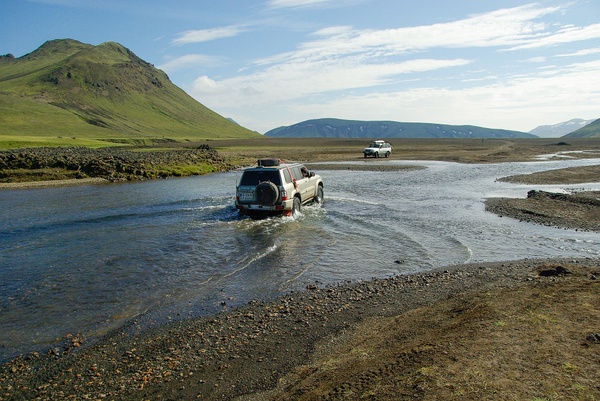The most fun thing you can do with your 4wd is a water crossing. It can also be the most challenging and expensive. Your 4wd is not an amphibious vehicle. Because they are not waterproof, the actual depth of water you can cross depends on the vehicle you are crossing in. Many soft roader vehicles cannot cross rivers and creeks at the same depth as a lifted Nissan Patrol for example. It is important to be prepared before attempting a water crossing. Inexperience and lack of preparation can cause a vehicle to become stuck very quickly. Prior to crossing water, it is a good idea to prepare your recovery equipment. In the case of getting stuck, you don’t want to be searching for your snatch strap while the water comes rushing in!
Preparation for Crossing Water
A rule of thumb when attempting to cross a river is “if you cannot walk it, you cannot cross it”. Make sure you always walk the crossing before you attempt to drive across. A 4wd vehicle will tend to float until water actually seeps into it. If the water height is above your wheel height, it is nearly always going to be impossible to pass. An added bonus of walking the crossing is you allow your axles / diff and gearbox time to cool down before you enter the cool water.
Diff Breathers
If a hot axle touches cool water, it will cool very rapidly. The air pressure inside the axle will be lowered and the diff housing will draw air through its breather. Extending your diff breather higher up on the vehicle will allow your diff to breath air instead of sucking in water whilst performing a crossing.
Air Intake Snorkels
When an engine breathes in water, it will almost always end in tears. Bent rods / valves and crankshafts are often the result. This is often a very costly repair and one to be avoided. The location of your air intake is very crucial to how well a vehicle can handle fording a water crossing. A common solution for this is to fit a snorkel. This relocates the air intake to near the height of your roof line. Snorkels also help when driving in dusty conditions allowing the engine to breathe cool clean air from up high.
Protecting Your Engine
Using a “water crossing bra” across the front of the 4wd will create a bow wave at the front of the car as long as you maintain momentum. The result will be less water in the engine bay and the radiator fan will not spray it over the ignition leads and spark plugs. It is also less likely the fan will try to propel its way into your radiator. A diesel vehicle is known to be better for water crossings as they have no ignition system. It is still advisable to proceed with caution in a diesel vehicle, however. If you do become stuck in the middle of a crossing, it is recommended to climb out of the window rather than open the door and flood your interior. It is a good idea to spray engine bay electrics and ignition with a water repelling agent such as WD40 before entering the water.
Radiator Fan
After you have sprayed your ignition and electrics, have a look at your radiator fan. Most 4wd’s have a viscous fan coupling driven by a belt from the engine crank. If you can turn the fan with the engine off, you have a viscous coupling. If you can’t turn the fan, you have a fixed coupling.
In case of the latter, you should disconnect your fan belt before attempting a water crossing. If you don’t, and water enters the engine bay, your fan may act as a propeller and bend forward digging into your radiator. Not something you want to find once you have made it through the water crossing!
Walking A Water Crossing
It is always recommended to walk a water crossing before attempting to drive it. When walking through the river crossing, make sure you walk where you intend to place your wheels so you can feel for hidden rocks or potholes. This will aide you in checking the depth of water in the crossing. Potholes (caused by others attempting the crossing and getting stuck) are an indication of the difficulty of the crossing and should be avoided when attempting to cross. If you can, it is a good idea to place markers or stand in place of potholes or large rocks in the crossing so as the driver can avoid them.
Water Crossing Driving Techniques
Visualise the path you wish to take through the water, remember where you walked and put the vehicle in low range. First or Second gear is good for creating just the right bow wave as well as allowing you the torque you need should the vehicle bog down. Speed is a very important factor when crossing a water crossing. Make sure you do not go too fast as it will send water straight into the engine bay and may flood the engine. Avoid using the clutch if possible as this may allow water to come between the friction plate and the flywheel. If you do start to feel a loss of traction, make sure you do not over-rev the engine. It is better to back off the accelerator and try to regain traction. If the engine stalls, put the vehicle in neutral with a minimum of clutch usage and attempt to escape the water in first gear low range.
Maintaining Your Car After A Water Crossing
When you are at the other side of the water crossing, and you’re back at home. Be sure to check the diff oil for water. This is a relatively simple job since oil floats on top of water. Simply release your diff oil drain bolt and allow a small amount of oil to drain into a container. You will be able to see the water in the oil as a milky white mixture. If you have water in your oil, make sure you drain the diff oil and replace it. It is also possible to flush the diff oil to remove all traces of water. Gearboxes, transfer cases and engine oil can also become contaminated with water after a water crossing. This usually will only occur if you become stationary in deep water. Check your other exterior mounted accessories such as winches, as these can size up unless maintained. Water crossings should be taken with caution as they have the potential to do a lot of damage. With the right preparation and maintenance, you can complete many uneventful water crossings with ease!
Water crossing Summary
• Vehicle Preparation
• Walk the crossing to check its depth.
• Don’t cross fast flowing water.
• Place markers at hidden obstacles.
• Place a tarp across the front of the vehicle.
• Disconnect the fan belt if a viscous coupling fan is not fitted.
• Spray water repellent on distributor and ignition wires.
• Pack recovery gear on top, ready for use.
Driving Technique
• Take off seat belt and wind down window.
• Use low range 2nd gear (in most situations).
• Drive at a steady speed to create a bow wave.
• Avoid using the clutch.
• Do not over-rev engine if you lose traction.
• If engine stalls, place in neutral without using clutch to restart. Take-off in 1st low.
• Post Water crossing maintenance
• Check diffs etc for water if depth above axles.
• Check winches if fitted

